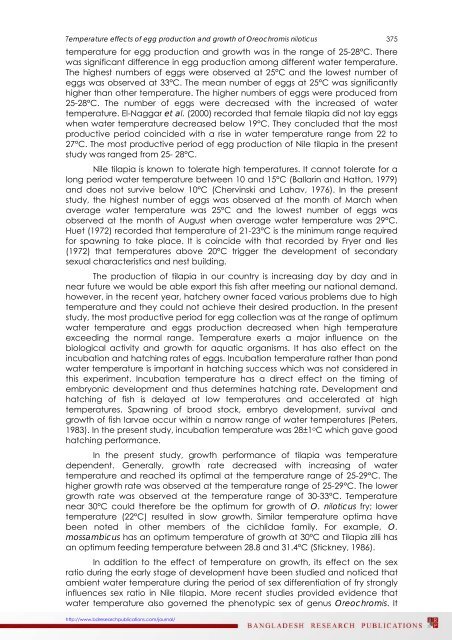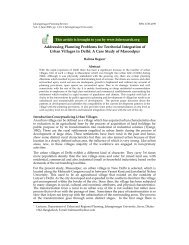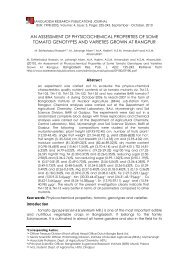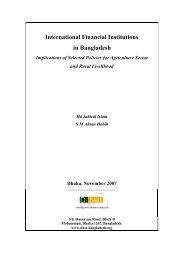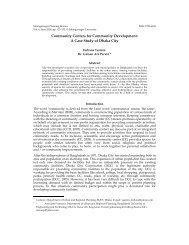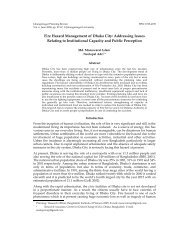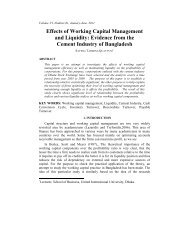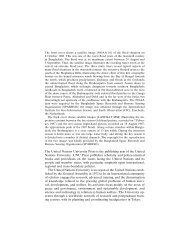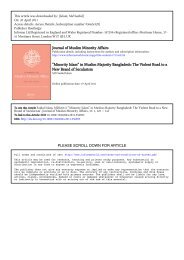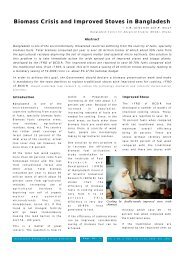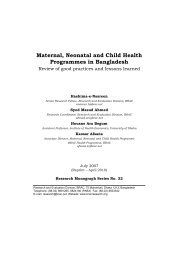EFFECTS OF TEMPERATURE ON THE EGG PRODUCTION AND ...
EFFECTS OF TEMPERATURE ON THE EGG PRODUCTION AND ...
EFFECTS OF TEMPERATURE ON THE EGG PRODUCTION AND ...
You also want an ePaper? Increase the reach of your titles
YUMPU automatically turns print PDFs into web optimized ePapers that Google loves.
Temperature effects of egg production and growth of Oreochromis niloticustemperature for egg production and growth was in the range of 25-28°C. Therewas significant difference in egg production among different water temperature.The highest numbers of eggs were observed at 25°C and the lowest number ofeggs was observed at 33°C. The mean number of eggs at 25°C was significantlyhigher than other temperature. The higher numbers of eggs were produced from25-28°C. The number of eggs were decreased with the increased of watertemperature. El-Naggar et al. (2000) recorded that female tilapia did not lay eggswhen water temperature decreased below 19°C. They concluded that the mostproductive period coincided with a rise in water temperature range from 22 to27°C. The most productive period of egg production of Nile tilapia in the presentstudy was ranged from 25- 28°C.Nile tilapia is known to tolerate high temperatures. It cannot tolerate for along period water temperature between 10 and 15°C (Ballarin and Hatton, 1979)and does not survive below 10°C (Chervinski and Lahav, 1976). In the presentstudy, the highest number of eggs was observed at the month of March whenaverage water temperature was 25°C and the lowest number of eggs wasobserved at the month of August when average water temperature was 29°C.Huet (1972) recorded that temperature of 21-23°C is the minimum range requiredfor spawning to take place. It is coincide with that recorded by Fryer and Iles(1972) that temperatures above 20°C trigger the development of secondarysexual characteristics and nest building.The production of tilapia in our country is increasing day by day and innear future we would be able export this fish after meeting our national demand.however, in the recent year, hatchery owner faced various problems due to hightemperature and they could not achieve their desired production. In the presentstudy, the most productive period for egg collection was at the range of optimumwater temperature and eggs production decreased when high temperatureexceeding the normal range. Temperature exerts a major influence on thebiological activity and growth for aquatic organisms. It has also effect on theincubation and hatching rates of eggs. Incubation temperature rather than pondwater temperature is important in hatching success which was not considered inthis experiment. Incubation temperature has a direct effect on the timing ofembryonic development and thus determines hatching rate. Development andhatching of fish is delayed at low temperatures and accelerated at hightemperatures. Spawning of brood stock, embryo development, survival andgrowth of fish larvae occur within a narrow range of water temperatures (Peters,1983). In the present study, incubation temperature was 28±1 o C which gave goodhatching performance.In the present study, growth performance of tilapia was temperaturedependent. Generally, growth rate decreased with increasing of watertemperature and reached its optimal at the temperature range of 25-29°C. Thehigher growth rate was observed at the temperature range of 25-29°C. The lowergrowth rate was observed at the temperature range of 30-33°C. Temperaturenear 30°C could therefore be the optimum for growth of O. niloticus fry; lowertemperature (22°C) resulted in slow growth. Similar temperature optima havebeen noted in other members of the cichlidae family. For example, O.mossambicus has an optimum temperature of growth at 30°C and Tilapia zilli hasan optimum feeding temperature between 28.8 and 31.4°C (Stickney, 1986).In addition to the effect of temperature on growth, its effect on the sexratio during the early stage of development have been studied and noticed thatambient water temperature during the period of sex differentiation of fry stronglyinfluences sex ratio in Nile tilapia. More recent studies provided evidence thatwater temperature also governed the phenotypic sex of genus Oreochromis. It375http://www.bdresearchpublications.com/journal/


